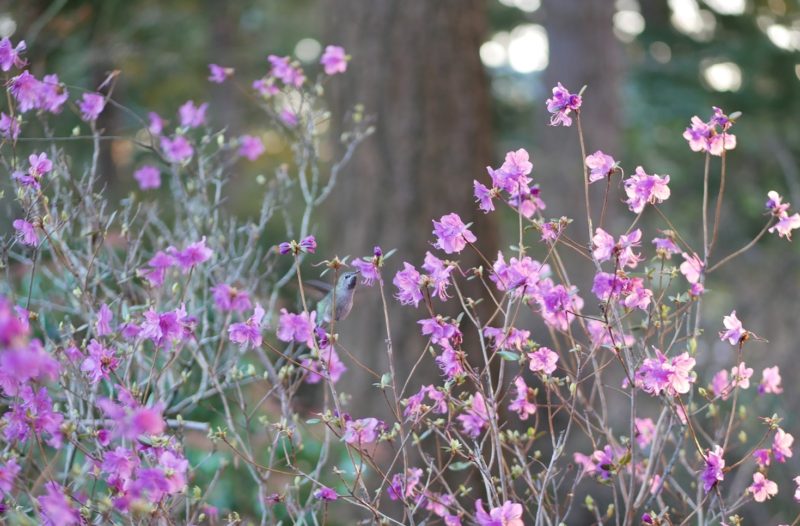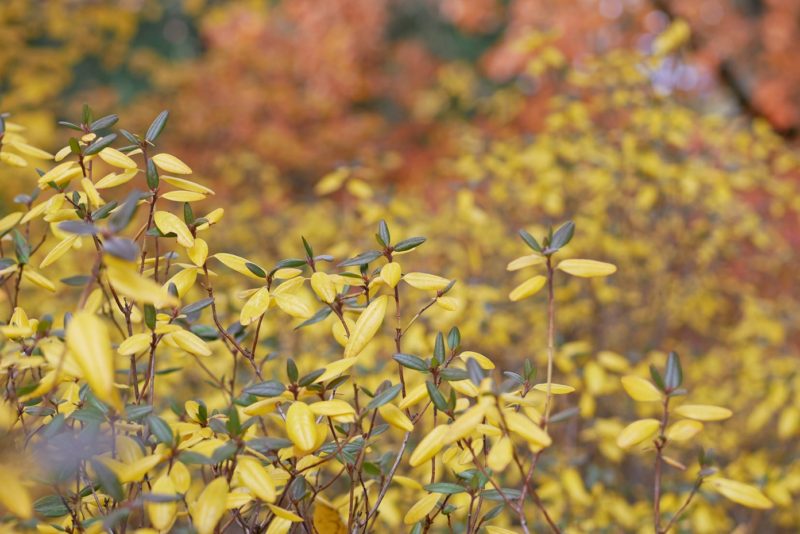by Will Clausen
In cold midwinter when little else is astir and most of the plants in the garden are in survival mode, one species of rhododendron is ready to burst into a cloud of pink. Rhododendron dauricum is a semi-evergreen thicket-forming shrub native to northeast Asia from Mongolia and northern China east into Siberia, Korea, and Japan. Its natural range covers areas that are among the most bitterly cold places on earth, and so it is unsurprising that R. dauricum is among the most winter hardy of all rhododendrons. Their hardiness, along with the unusually early blooming period, makes them a desirable and useful plant for gardeners who live in areas that are too cold in the winter to grow the full assortment of Rhododendron species. In fact, many gardeners are more familiar with this far-flung species than they might realize because the common rhododendron cultivar series ‘P.J.M.’ is derived from a cross of an evergreen form of R. dauricum and R. minus var. minus (syn. R. carolinianum).
Rhododendron dauricum isn’t just a useful plant, it’s also incredibly beautiful. The bright pink flowers would brighten up a garden in peak spring bloom, but they are made all the more vibrant thanks to an absence of almost any other color aside from green and brown. When the sun pierces through the clouds and light glances sideways across the garden at its lowest winter angle, the pink flowers glow. Here in Washington, Anna’s hummingbirds clamor over these nectar factories for the invaluable energy that they supply. In its native habitat, R. dauricum grows in forest margins, often among birch with which it makes a beautiful combination. A wave of pink flowers hanging among scattered white trunks.
The leaves are probably my favorite thing about R. dauricum, though not really for the way they look but rather for their scent. These small scaly leaves are among the most fragrant in the genus. Crushing individual leaves through the spring and summer unlocks the fragrance, but it isn’t necessary because simply brushing your hands through the shrub is enough to carry the spicy sweet smell of cloves into the air. The essential oils permeating the leaves of R. dauricum are comprised of a complex mixture of chemicals dominated by trans-Caryophyllene, a natural product also found in high concentrations in plants like cloves, cinnamon, basil, hops, and cannabis. The benefits of such a plant in the garden cannot be overstated. I make sure to brush my arms through R. dauricum as often as I can and doing so always lifts my spirits. Even though it plays second fiddle in my mind, the leaves do provide some pleasant visual qualities for the garden as well. Late in the fall, the deciduous leaves along the branches turn a rich shade of yellow which persists for a week or two before they fall to the ground. At the tips of the stems, a few leaves which tend to be persist through the winter cluster around the floral and vegetative buds. These leaves are a dark green color, but some deepen so much that they look nearly purple. The temporary two-tone fall color is really nice, and you shouldn’t be surprised by one or two errant flowers starting to bloom a couple of months early and adding a little bit of pink to the yellow and purple.
References
Cox, P., and Cox, K., 1997. The Encyclopedia of Rhododendron Species. Glendoick Publishing.
Olennikov, D.N., et al., 2009. Chemical Composition of the Essential Oils from Leaves of Rhododendron dauricum and R. aureum. Chemistry of Natural Compounds, Vol. 45, No.3.
Chemical composition of essential oils from leaves of Rhododendron dauricum and R aureum


